4 Pain-Free Exercises That Build Muscle Without Stress After 50
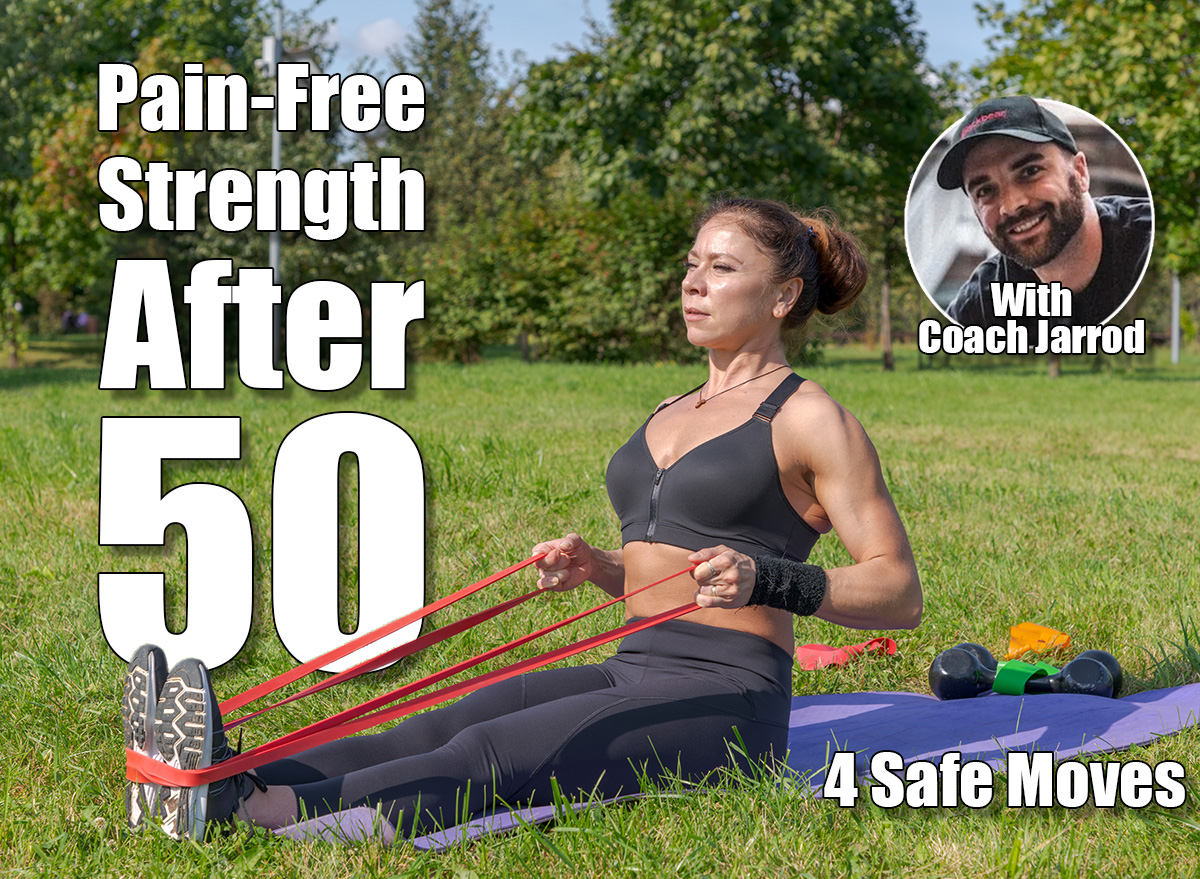
As you get older, your workouts need to evolve. This doesn’t mean you stop training hard or aiming high; it reinforces the idea of training smarter. The wear and tear add up over time. Joints ache more often. Recovery takes longer. The margin for error shrinks. What once felt good might now feel off. That’s when most people stop lifting or give up entirely. But that’s not the answer.
The right strength exercises can build muscle, protect your joints, and help you feel younger. The key is to choose movements that work with your body, rather than against it. They should build strength without causing unnecessary stress, discomfort, or burnout. And they should train the muscles that matter most for long-term function, mobility, and power.
As a certified performance coach with over ten years of experience, I’ve worked with clients at every stage of life. I’ve trained elite athletes and everyday adults. I’ve seen how a few clever tweaks can help someone continue training well into their 50s, 60s, and beyond. I’ve made those tweaks myself. Injuries, surgeries, and the daily grind forced me to rethink how I move and how I coach.
The following four exercises are pain-free, joint-friendly, and still pack a serious strength punch. They are simple to learn, easy to modify, and perfect for building muscle after 50 without adding unnecessary stress.
4 Pain-Free Exercises to Build Muscle After 50
Exercise #1: Box Squats
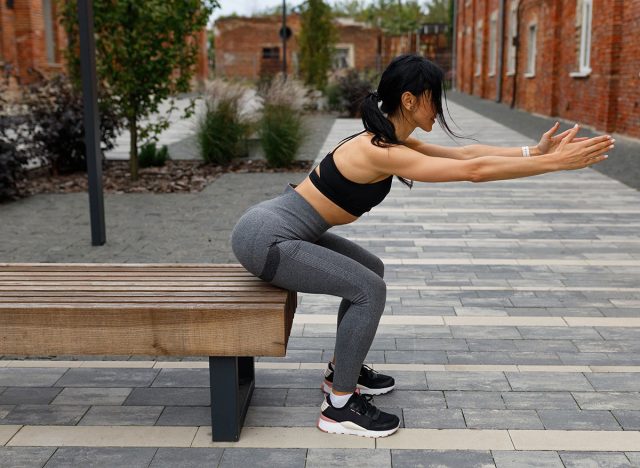
Box squats strengthen your lower body while improving control and stability. Sitting back to a box or bench helps reduce pressure on the knees and lower back while reinforcing proper squat technique.
Muscles Trained: Quads, glutes, hamstrings, core
How to Do It:
- Stand in front of a sturdy box or bench with your feet shoulder-width apart.
- Brace your core and keep your chest tall.
- Push your hips back and bend your knees to lower toward the box.
- Tap the box with control without fully relaxing.
- Drive through your heels to return to a standing position.
- Repeat for all reps, maintaining tension in your legs and glutes.
Recommended Sets and Reps: Knock out 3 sets of 6 to 12 reps. Rest for 60 seconds between each set.
Best Variations: Bodyweight box squat, goblet box squat, barbell back box squat
Pain-Free Form Tip: Use a box height that allows your thighs to stay in a position parallel to the floor. Avoid dropping too low if your knees or hips feel tight.
Exercise #2: Incline Push-Ups
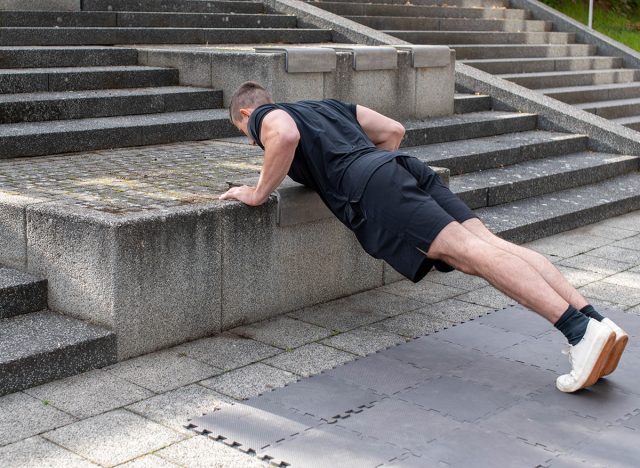
Incline push-ups build upper body strength while taking stress off your shoulders and wrists. Elevating your hands on a bench or countertop makes the movement more joint-friendly and easier to control.
Muscles Trained: Chest, shoulders, triceps, core
How to Do It:
- Place your hands on a bench, box, or countertop just outside shoulder-width.
- Walk your feet back to form a straight line from head to heels.
- Brace your core and keep your body as flat as possible.
- Lower your chest toward the bench with control.
- Stop before your chest touches, then push back to the starting position.
- Maintain a steady tempo and focus on clean reps.
Recommended Sets and Reps: Knock out 3 sets of 12 reps. Rest for 45 seconds between each set.
Best Variations: Wall push-up, kitchen counter push-up, feet-elevated incline push-up
Pain-free Form Tip: Keep your elbows at a 45-degree angle to your body. Don’t let them flare out wide.
Exercise #3: Resistance Band Rows
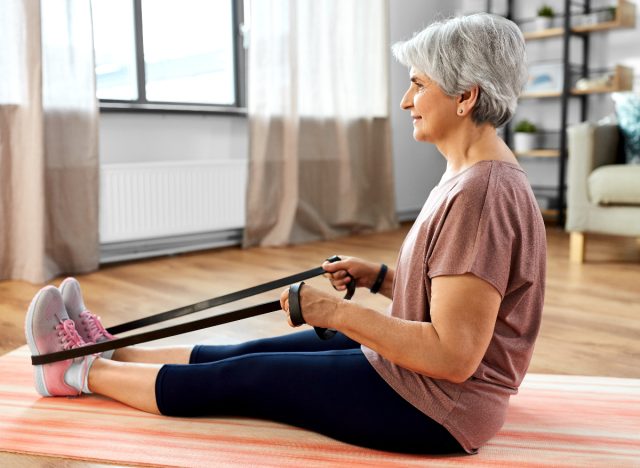
This is one of the best upper-body pulling exercises for building back strength without straining the joints. The band creates smooth, controlled resistance that is easy on the shoulders and elbows.
Muscles Trained: Lats, rhomboids, biceps, rear delts
How to Do It:
- Anchor a resistance band at chest height or sit with the band wrapped around your feet.
- Grab the handles or ends with both hands.
- Sit or stand tall with your chest up and arms extended.
- Pull the band toward your ribcage while squeezing your shoulder blades together.
- Slowly return to the start position.
- Stay controlled and avoid jerking the band.
Recommended Sets and Reps: Knock out 3 sets of 15 reps. Rest for 45 seconds between each set.
Best Variations: Seated band row, standing band row, one-arm band row
Pain-free Form Tip: Keep your shoulders down and avoid shrugging as you pull.
RELATED: 5 Classic Exercises Men Should Do Every Day to Stay Young After 45
Exercise #4: Glute Bridges
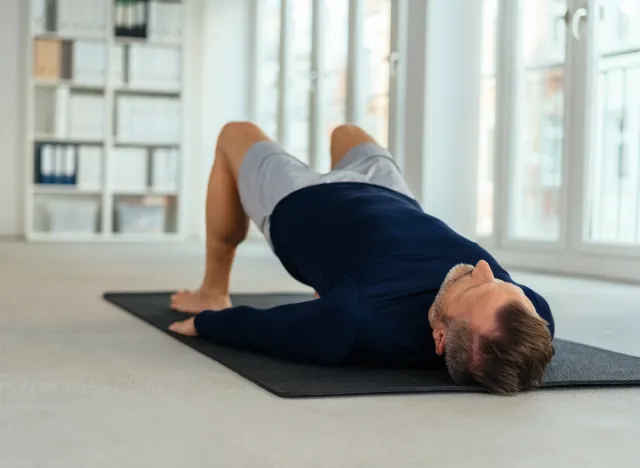
Glute bridges strengthen your hips, hamstrings, and core without putting pressure on your knees or back. They’re ideal for building posterior chain strength from the ground up.
Muscles Trained: Glutes, hamstrings, lower back, core
How to Do It:
- Lie on your back with your knees bent and feet flat on the floor.
- Place your arms by your sides with palms down.
- Brace your core and squeeze your glutes.
- Push through your heels to lift your hips toward the ceiling.
- Pause briefly at the top, then lower with control.
- Keep your ribcage down and avoid arching your back.
Recommended Sets and Reps: Knock out 3 sets of 15 reps. Rest for 30 seconds between each set.
Best Variations: Feet-elevated glute bridge, banded glute bridge, single-leg glute bridge
Pain-free Form Tip: Drive through your heels to avoid overusing your lower back.
The Most Optimal Ways to Train Pain-Free After 50
The best results after 50 come from innovative training. Pain-free doesn’t mean easy; it means effective, sustainable, and adaptable. These tips can help you stay strong without setbacks.
- Train with control, not momentum: Slow, deliberate reps build more muscle and protect your joints.
- Use resistance that challenges, not crushes: You should finish sets with a few reps in the tank. That balance promotes muscle growth without overloading your body.
- Prioritize good form over heavy weight: Movement quality beats numbers. Good form builds strength and prevents injury.
- Add recovery as a priority: Schedule rest days and incorporate light movement into your routine. Recovery drives progress, especially as you age.
- Avoid pain, not discomfort: Some muscle burn is good. Joint pain, sharp pinches, or instability are not.
- Stick to what feels good: Everyone is different. Adjust your stance, grip, or exercise selection based on how your body responds.